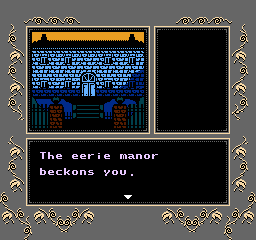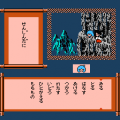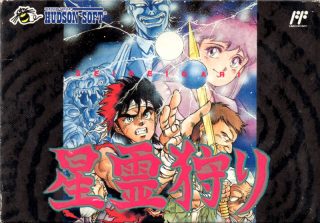
Famicom Cover
In the late 80s, Hudson Soft started making adventure games such as Princess Tomato in the Salad Kingdom (one of the few Famicom adventure titles to be officially localized) and licensed games based on the Space Adventure Cobra series. Among these was Seirei Gari (or “Ghost Hunter”), a spooky straightforward adventure title worth recommending to newcomers of the genre.
You play as Michimune, who is celebrating his friend Miu’s 18th birthday with her grandfather. Suddenly, a demonic face called Rosenkreuz appears and snatches Miu away, declaring that after waiting 100 years, the world is finally his. Michimune tries to stop Rosenkreuz, but he knocks Michimune out and kills the grandfather in the process. Waking up in a hospital, Michimune teams up with Kiyojo, a doctor aware of Rosenkreuz’s history, and they set out to rescue Miu and stop Rosenkreuz’s plans.
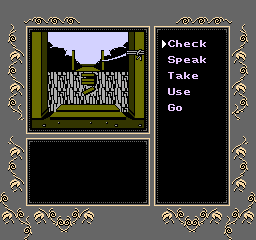
Seirei Gari is an adventure game where you make progress by talking to people, gathering information and items, and solving light puzzles with what you find. You have your usual command menu on the side, which presents you with a handful of actions such as examining the area, speaking to whoever’s there, taking and using items, and moving to a different location. You can also ask Kiyojo for help if the situation calls for it, usually in giving you information or very occasionally having him do something for you.
Every now and again, the game will change things up with sections where you navigate mazes through moving from room to room in the cardinal directions. These sections tend to be the most intense in terms of puzzling, since you have to navigate your way around and the later mazes are the only places where you can get a game over. (On that note, passwords for your current position can be accessed by pressing Select at any time, and make sure to note them since they’re 48 characters long!)
Surprisingly less challenging are the monster encounters that occur, where you’ll have to defeat a monster before you can move on. There’s always a specific sequence to pull off, and you’re not allowed to pick options that would otherwise get you killed. Apart from the later maze sections, it’s impossible to get a game over and you’ll never lose out on whatever item or info you need to proceed.
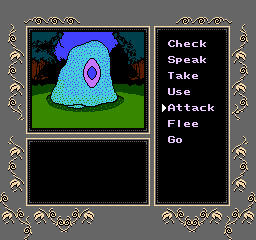
Seirei Gari is generally a streamlined experience, owing to the small number of actions you can perform and how the game’s structured overall. The adventure is comprised of chapters in which you move from one area to the next in a linear order. You can’t return to previous areas, so there’s never a need to backtrack if you’re stuck. The answer will always be nearby, and the solutions mostly follow an intuitive logic such as looking around, talking to people a few times or asking Kiyojo for advice. It can help to take notes, but there’s not as big a need as there could be for other adventure games on the system.
This is quite an easy game, which can be disappointing if you’re used to more complex puzzles and locales, but it can also be great if you’re new to adventure games and want a concise starting point. Chapters are briskly paced, so you’ll never spend too long in any area, and there’s purpose in moving on thanks to how clearly the game conveys information. What you do in each section is varied enough to make for an adventure where you never know what’s around the corner, though the focus is less on the story and more on the individual mysteries and scrapes you get into.
Despite being described as a horror game, the emphasis is more on creating a spooky vibe through strange places and the odd monster encounter rather than trying to evoke dread or terror from the player. Conversations are brief and to the point, Michimune and Kiyojo are never distraught in their search for Miu, and there’s even a few silly or funny moments sprinkled throughout.
The presentation does a decent job at trying to carry this atmosphere, with the graphics pushing some solid monster designs, many distinct looking locales, and a neat use of colors in creating a mood for each section of the game. Less impressive is the music by Osamu Kasai and (possibly) Masaaki Harada, which only has a handful of short pieces used throughout. Although they’re decently composed and manage to instill some dread on occasion, they tend to overstay their welcome and make the overall adventure feel more repetitive.
Seirei Gari was made in collaboration with software company Sofix, who assisted Hudson Soft with various PC Engine titles. They also helped worked on the Down Load games, along with prominent members of Seirei Gari‘s development team such as scenario writer Wataru Nakajima and character designer Masaomi Kanzaki.
An English fan translation was released back in 2007 by Boojum Snark, who produced a handful of translations for other Famicom adventure games in the late 00s/early 10s such as Kujaku Ou and Kaguya Hime Densetsu.
Links:
The English fan translation patch: https://www.romhacking.net/translations/1279/
An addended version of the English fan translation patch to fix minor errors (should be applied on top of the original patch): https://www.romhacking.net/translations/2612/

